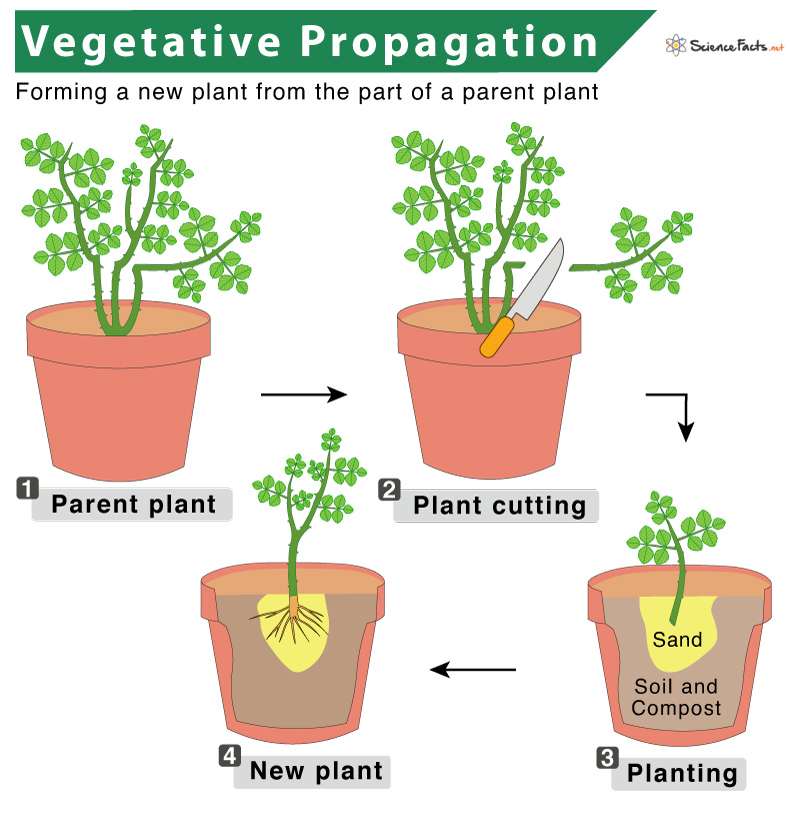It is widely used to make copies of plants in large numbers in a short period. The majority of plants found in nurseries were all made through vegetative propagation. It occurs through the fragmentation and regeneration of specialized vegetative plant parts. Many plants propagated vegetatively can also reproduce sexually. Apart from plants, vegetative reproduction, such as fragmentation, fission, and budding, are also found in fungi.
Process of Vegetative Propagation
Types of Vegetative Propagation
Advantages of Vegetative Propagation
Disadvantages of Vegetative Propagation
Vegetative propagation requires tissues containing undifferentiated cells, called meristems. These tissues repeatedly divide by mitosis to allow rapid development in plants. The ability of meristem tissue to divide repeatedly allows growth and regeneration of plant parts. Specialized, permanent plant tissues later develop from meristem tissue.
1. Artificial Vegetative Propagation
This process requires human intervention. Farmers and horticulturists widely use artificial vegetative propagation to develop crops with enriched nutrients, pest resistance, and a high turnover rate. Some common ways of artificial vegetative propagation are described below: a. Cutting: A plant part such as a stem or leaf is cut off and planted, which develops adventitious roots and develops into a new plant. This process also uses hormones before plantation to induce root development. b. Grafting: Here, the cutting from some other plant or scion is attached to the stem of a plant rooted in the ground. With time, the tissues of the graft unite with the tissues of the rooted plant to form a single plant. c. Layering: It involves bending plant branches or stems, touching them to the ground, or being covered entirely with soil. Adventitious roots form in the parts covered by soil. This attached stem with developing roots is known as a layer. d. Suckering: Suckers attach to a parent plant forming a compact mat. Mature suckers are detached from a parent plant and transplanted to a new place where they develop into a new plant. e. Tissue Culture: It involves culturing plant cells from different parts of a parent plant. The tissue is cultured in a sterile nutrient-rich medium until a mass of cells known as a callus is formed. The callus is then cultured in a hormone-rich medium until they develop into plantlets. When planted in the soil, the plantlets grow into mature plants.
2. Natural Vegetative Propagation
Certain plant parts grow and develop naturally without any artificial means. Such parts develop adventitious roots from a parent plant’s stems, roots, or leaves. Some common vegetative structures that arise from plant stems are: a. Rhizomes are modified stems that grow and extend horizontally along the surface or beneath the ground. They store foods such as starches and proteins, later used by the developing plant. Grasses, lilies, and orchids propagate by forming rhizomes. b. Runners or Stolons grow like rhizomes horizontally along the surface or beneath the ground. However, unlike them, runners develop from existing stems. As runners grow, they develop roots from buds in the nodes or the tip. New plants arise at nodes where shoots develop. Strawberry plants and currants propagate through this process. c. Bulbs are round, and swollenparts of the stem are found underground. Within bulbs lies the central shoot of a new plant. A bulb consists of a bud surrounded by layers of fleshy, scale-like leaves, which provide food to the growing plant. Onions, garlic, lilies, and daffodils develop from bulbs. d. Tubers may arise from stems or roots.Stem tubers such as potatoes and yams develop from rhizomes or runners that store food and become swollen. The upper surface form a new plant shoots system, while the lower surface forms the root system. These roots later give rise to a new plant. Like stems, root tubers of sweet potatoes and dahlias develop from roots that are modified to store nutrients. e. Corms are bulb-like underground stems. They store nutrients in their fleshy stem and are surrounded by papery leaves. Though similar to bulbs, corms contain solid tissue internally, whereas bulbs have layers of leaves. Crocus, gladiolus, and taro are some plants that develop from corms. f. Plantlets are short-sized plants that develop on the leaves of another plant. They arise from meristem tissue located along leaf margins. When mature, they develop roots and drop down from the leaves, which develop real roots in the soil to form a new plant. Kalanchoe propagates by forming plantlets.
All the propagated plants (clones) have the same characteristics as the parent plant.Offspring are produced faster than sexual reproduction and thus are a rapid plant growth and development method.Significantly reduces energy expenditure of sexual reproduction in plants.Independent of pollinating agents like wind, water, and insects necessary for fertilization in sexual reproductionOnly a single plant is sufficient to give rise to offspring.
Do not provide new variety in plants as the process of evolution is absent. Those plants are prone to diseases.Overcrowding around the parent plants retards the growth of the new plants.Plants are short-lived compared to those obtained by sexual reproduction.Expensive compared to sexual reproduction as it requires skilled personnel.
